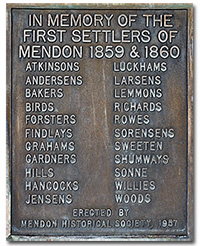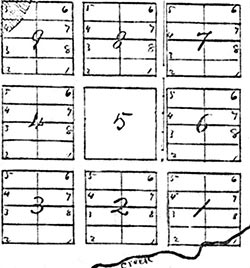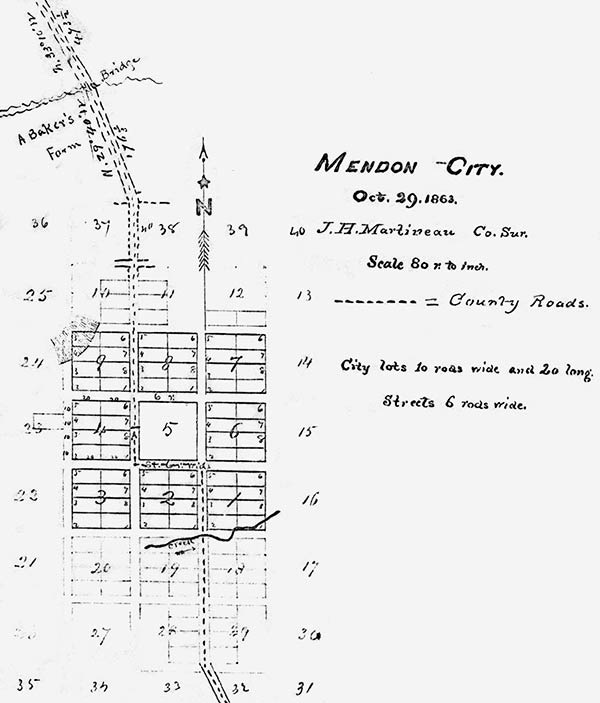History of Mendon & Second Oldest Town in Cache Valley ~ Index

The Settlement of Mendon was commenced in 1857 by Alexander and Robert Hill, (Bancroft's History of Utah, page 597). During the year of 1859 the following families arrived: Roger Luckham, Charles Atkinson, Charles Bird, Jr. and William Bird, Nicolai Sorensen, John K. Richards, Ralph Forester, Robert Sweeten, Hans Jensen, William Findley, Jr., James H. Hill, Isaac, Abraham, and Peter Sorensen, James G. Willie, Charles Shumway, Hans Peter Larsen, Kelsey and Bradford K. Bird, Andrew Andersen, and Jasper Lemmon.
August 10th, 1859 Jesse W. Fox, Sr., a surveyor from Salt Lake City, surveyed and laid out this old fort, also the fields adjoining the town. At this time the pioneers were living in their tents and wagons. They now built their log houses and dugouts. The buildings all faced each other, a row on each side of the street, about two blocks long, their corrals being at the back.
Charles Shumway and his son, Andrew P. Shumway took up farms at Mendon in the spring of 1859. Charles Shumway was then authorized to take charge of the public affairs of the new settlement until his son; Andrew P. Shumway was ordained bishop on December 19th, 1859. The first meeting were held in private cabins during the winter. Rodger Luckham led the singing. Ira Ames played the fiddle.

In the spring of 1860 the following families arrived: Edward Wood, Manning Rowe, Adam Craik Smyth, Amenzo W., George W. & Albert M. Baker, and John Donaldson. In the winter of 1859-1860 the men of the fort went to the canyons of Cache Valley, both east and west to get fine logs with which to build a public house. The structure was eighteen by twenty-four feet and served for worship, school and recreation.
On one occasion when Brigham Young, Heber C. Kimball, and others church authorities were making a tour of Cache Valley, Heber C. Kimball, suggested that the fort be named Mendon City in remembrance of Mendon City in New York State, where he and Brigham formerly resided.
In early spring of 1861 a United States Post Office was established in Mendon. James G. Willie was appointed Post Master. The mail was brought in on horseback once a week from Ogden.
In the winter of 1860-1861 the first school was opened. Amenzo W. Baker was the first teacher, being followed by Jasper Lemmon, Adam Craik Smyth and John Donaldson.
In the early spring of 1861 the men turned out in mass to construct the big dam across Gardener's Creek to irrigate the farms.
John Hill Richards was buried September 30th, 1861. He was the first person to be interred in the Mendon City cemetery. Amenzo W. Baker was the first Sexton.
Mary Ann Sorensen Hill, daughter of Abraham and Mary Jensen Sorensen, was born February 19th, 1860, and has the distinction of being the first child born in Mendon. Mathew M. Forester, son of Ralph and Margaret McKeen Forester, born March 29th, 1860 was the second child born in Mendon.
James H. Hill and Christina Sorensen were the first people married here. James G. Willie performing the ceremony January 7th, 1860. Henry Hughes and others arrived in 1862.
Adam C. Smyth organized the first choir and was chorister. In the spring of 1862,1863 and 1864 Jasper Lemmon, Amenzo W. Baker, Ralph Forester, Isaac Sorensen, and Joseph H. Richards drove ox teams from Mendon to Omaha, Nebraska and to the Missouri River and returned bringing the poor immigrant Saints. (P.E.F.)
In 1862-1863 Nicolai Sorensen, Rodger Luckham, Robert Sweeten, and John K. Richards raised flax and made jute from the bark, which was converted into wrap from which they made home spun cloth and grain sacks. John K. Richards raised hemp for poultry, food, etc. and ropes and cords were made from the bark.
The first Sunday school was held in Mendon in 1863 with James G. Willie as superintendent from 1863 to 1866, followed by Ralph Forester, 1866 to 1875, John Donaldson, 1875 to 1884, Isaac Sorensen 1884 to December 31, 1899. He was also choir leader and Sunday school chorister for many years.
Joseph Baker built the first rock dwelling house in 1866.
In 1864 a stone chapel was built, twenty-eight by forty-five feet, at it's completion it was considered the finest church in the valley.
George Thurston and Kelsey Bird built the Mendon gristmill in 1864 on Gardener's creek.

Thomas B. Graham was killed by a large grizzly bear, while after a load of willows three and one half miles southeast of the fort on Little Bear River, known as Muddy River. Men from Mendon and Wellsville armed with guns were soon on the scene. The bear was killed by James H. Hill of Mendon; one of the cubs was killed by Joseph H. Richards of the fort. The other cub got away.
In 1866 the people built a stonewall around the church house for protection against the cruel, treacherous Indian. This wall was six feet high and enclosed about one acre of land. Bastions were built at the northeast and southwest corners with port holes to guard each side of the outer walls.
In 1866 (or 1868) the women's Relief Society was organized with Elizabeth Willie as president, followed by Maria Baker, Mary I. Sorensen, Mary Baker Jensen, and Mary A. Bird.
In the summer of 1867-1868 the gardens and farms were devastated by unnumerable, monstrous black crickets and flying grasshoppers. Men, women and children turned out and waged against the pests. The crickets were driven into and under thinly strewn straw and burned or driven into trenches and left to die of starvation. The grasshoppers were on wing all day until late afternoon. The sun was visible only as we see it dimly during an eclipse through a smoked glass. In the well-spent afternoon they would all light on the fields and if not driven away would remain all night and destroy the grain.
April 1st, 1869 a co-operative mercantile store was organized with James G. Willie as general manager and chief clerk. Their motto was, small profits and quick returns. Alfred Gardener was assistant manager.
George Thurston's little girl, two and one half years old, was stolen by the Indians April 7th, 1869. Every effort possible was made to find her, but without avail. The mother was heart broken and grieved constantly.
May 10th, 1869 Bishop Andrew P. Shumway was called as a missionary to Great Britain, where he labored until August 16th, 1871. Henry Hughes was appointed as acting bishop in his absence.
October 6th, 1872 Henry Hughes was ordained bishop and acted as such until October 8th, 1873 when he went to Wales on a mission. Ralph Forester served as acting bishop until his return in 1875. He remained bishop until 1900.
December 19th, 1872 the first railroad steam engine with its tender and nicknamed John W. Young ran into Mendon on the Utah Northern Railway. December 22nd, 1872 the first train, consisting of a passenger car, one box car, and two flat cars, drawn by a steam engine arrived in Mendon and the children were invited to take a ride. Mendon was now connected with Ogden by rail and Ogden with Salt Lake City.
December 30th, 1875 the Young Men's Mutual Improvement Association was organized with John Donaldson as president. October 25th, 1877 the Young Women's Mutual Improvement Association was organized with Larsine Sorensen Richards as President. The Primary association was organized with Martha Paul as President. It was organized on June 3rd, 1879.
Sometime between the years of 1882-1885 Frank Williams organized the Marshal Band of young boys. He also introduced the maypole dance, which is still celebrated.
The later improvements are the culinary water system, which was installed March 6th, 1912 and is among the best in the state of Utah. In 1915 the electric railway trains ran into Mendon. The electric lighting system was installed in Mendon by the Utah Power and Light Company, 1916.
Mendon has produced doctors, lawyers, professors, professors of music, forty-one first class school teachers, twenty-three trained nurses and about forty world war I veterans. A brick church house was built in 1915.1
Notes…
This history of Mendon, Utah came to me in a box of papers that I call the Abraham Sorenesen Papers. It contains several documents, histories and a few photographs, it came to me by way of Joseph N. Sorensen, a son of Abraham Sorensen. Joseph N. Sorensen adopted two children, a boy and a girl, it seems neither wished to have nor keep these papers. So they were offered to me, of which I am most grateful.
- History of Mendon & Second Oldest Town in Cache Valley, taken from the Abraham Sorenesen Papers, written about 1925.